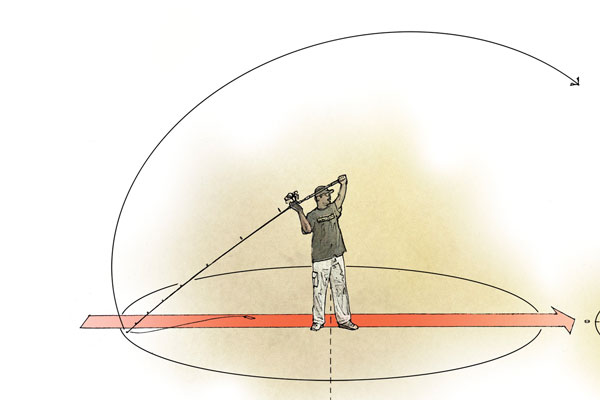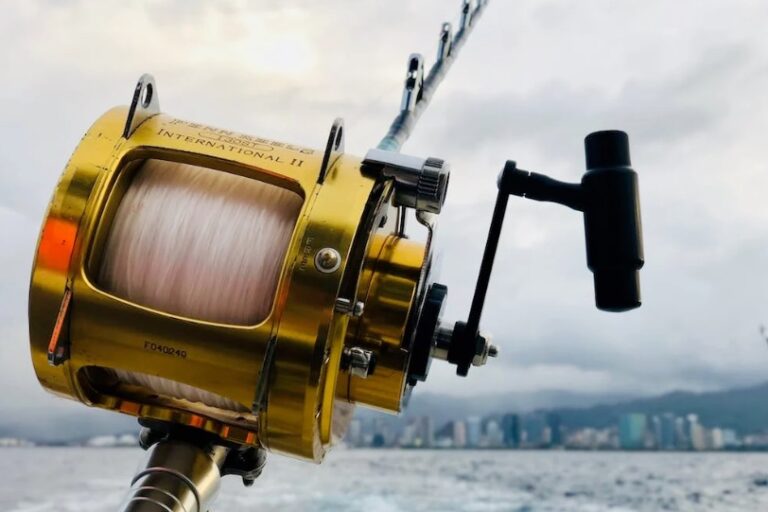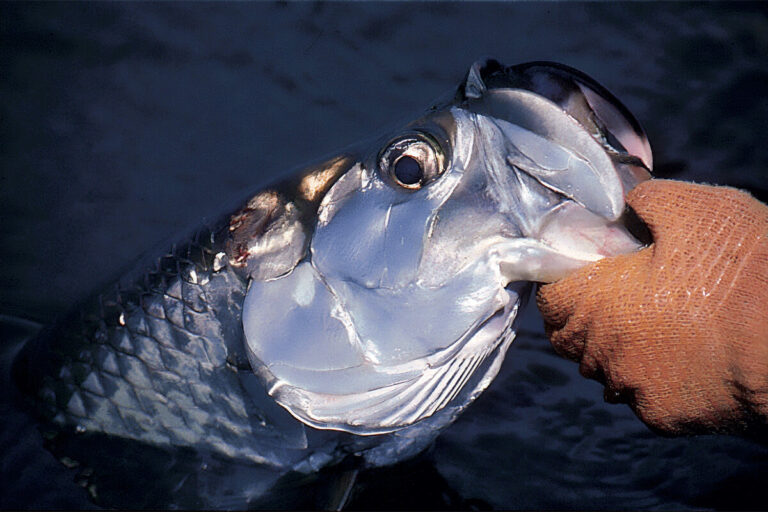To string a baitcasting rod, first, loop the line through the rod’s first guide and tie it securely. Then, make sure to pass the line through each guide and reel it onto the spool evenly to prevent tangling.
A baitcasting rod is a versatile tool for anglers looking to improve their fishing game. Whether you’re a seasoned angler or just starting out, it’s essential to know how to properly string a baitcasting rod to ensure smooth casting and reeling.
In this guide, we will provide you with easy-to-follow steps to string your baitcasting rod accurately. By following these steps, you’ll be ready to hit the water and improve your chances of reeling in that elusive catch. So, let’s dive in and learn how to string a baitcasting rod like a pro.

Credit: www.curated.com
Understanding The Components Of A Baitcasting Rod
A baitcasting rod is a versatile tool that can greatly enhance your fishing experience. Whether you’re a beginner or an experienced angler, understanding the components of a baitcasting rod is essential for optimal performance. In this section, we’ll explore the reel seat, handle, guides, and other parts of a baitcasting rod, helping you make an informed choice when selecting the right rod for your needs.
Overview Of The Baitcasting Rod And Its Components
- Reel seat: The reel seat is where the fishing reel is attached to the rod. It provides stability and allows for easy maneuverability while casting and retrieving. Look for a secure reel seat that can accommodate your reel size.
- Handle: The handle is where you grip the rod while fishing. It should provide a comfortable and ergonomic grip to minimize fatigue. Consider the length and material of the handle, as it can affect the balance and overall feel of the rod.
- Guides: Guides are small rings through which the fishing line passes. They help distribute the weight and reduce friction during casts and retrieves. Opt for high-quality guides that are durable and smoothly guide the line without causing any tangles.
- Blank: The blank refers to the main body of the rod, excluding the handle and guides. The material and construction of the blank determine the rod’s strength, sensitivity, and flexibility. Common materials include graphite and fiberglass, each with its own advantages and characteristics.
- Butt and tip: The butt of the rod is the thicker end, which rests against your body when fishing. The tip is the thinner, more flexible section that detects even the slightest movements or nibbles from fish.
- Reel: While not a direct component of the baitcasting rod, the reel is crucial for its functionality. Choose a reel that complements your rod’s capabilities and matches your fishing style and target species.
- Extras: Some baitcasting rods may have additional features like hook keepers, line holders, or adjustable mechanisms. Consider these extras based on your specific preferences and fishing needs.
Exploring The Reel Seat, Handle, Guides, And Other Parts
- Reel seat:
- Ensure the reel seat is compatible with the type and size of reel you plan to use.
- Look for a reel seat that firmly secures the reel in place to prevent any wobbling or slippage during use.
- Consider the material of the reel seat, such as graphite or aluminum, which affects its durability and weight.
- Handle:
- Choose a handle length that feels comfortable for your grip and fishing style. Longer handles provide greater leverage for powerful casts, while shorter handles offer more control and precision.
- Pay attention to the handle material, such as cork or eva foam, as it affects grip comfort, sensitivity, and durability.
- Some handles come with additional features like extended butt grips or ergonomic shaping, offering enhanced comfort during long fishing sessions.
- Guides:
- Look for guides that are smoothly mounted and aligned along the entire length of the rod.
- Consider the number of guides and their placement, as it affects the rod’s overall flexibility and line guidance.
- Opt for guides made from materials like ceramic or titanium, known for their smoothness and resistance to wear.
- Blank:
- Determine the type of fishing you’ll primarily be doing to select the appropriate blank material. Graphite rods offer sensitivity and responsiveness, while fiberglass rods provide durability and strength.
- Consider the action of the rod, which refers to its bending and flexibility. Fast-action rods bend mostly in the tip section, while slow-action rods bend throughout their length. Choose according to your fishing techniques and target species.
Choosing The Right Type Of Baitcasting Rod For Your Needs
- Determine your fishing goals: Are you primarily targeting freshwater or saltwater species? Are you going for bass fishing or tackling larger fish species?
- Consider your fishing style: Do you prefer finesse fishing, heavy casting, or trolling? Each fishing style may require a different rod type and action.
- Assess your skill level: Beginners may benefit from a more forgiving rod with a slower action, while experienced anglers might prefer a higher-performance rod with greater sensitivity.
- Research rod specifications: Look into rod length, power, and lure weight recommendations to match them with your specific fishing techniques and target species.
- Test and compare rods: Whenever possible, try casting different rods to feel their flexibility, weight, and overall comfort in your hands. This will help you find the perfect balance for your needs.
With a solid understanding of the components of a baitcasting rod, you can confidently choose a rod that suits your fishing style, goals, and skill level. By carefully considering the reel seat, handle, guides, and other parts, you’ll be well on your way to enhancing your fishing experience and reeling in the big catches.
Happy fishing!
Selecting The Perfect Fishing Line
When it comes to baitcasting rods, selecting the right fishing line is essential for a successful fishing experience. The fishing line not only serves as a connection between you and your catch, but it also plays a crucial role in determining the casting distance, strength, and sensitivity.
To ensure you choose the appropriate fishing line for your baitcasting rod, let’s examine different types of fishing lines and their characteristics.
Examining Different Types Of Fishing Lines And Their Characteristics
There are several types of fishing lines available in the market, each with its own unique characteristics. Understanding these differences will help you choose the right one for your baitcasting rod. Here are the key points to consider:
- Monofilament fishing line:
- Versatile and widely used fishing line.
- Offers good strength and knot retention.
- Ideal for beginners due to its forgiving nature.
- Provides moderate sensitivity and stretches to absorb shocks.
- Fluorocarbon fishing line:
- Virtually invisible underwater.
- Offers excellent abrasion resistance.
- Sinks faster compared to monofilament lines.
- Provides a higher level of sensitivity and less stretch.
- Braided fishing line:
- Made from woven fibers, providing exceptional strength.
- Offers minimal stretch, ideal for detecting subtle bites.
- Provides superior casting distance.
- Highly durable but may be visible in clear water.
By considering the characteristics of each fishing line type, you can select the one that best suits your fishing needs and preferences.
Understanding Line Weight And Line Capacity For Baitcasting Reels
Line weight and line capacity are crucial factors to consider when selecting a fishing line for your baitcasting reel. Here’s what you need to know:
- Line weight:
- Determines the maximum load the line can handle.
- Match the line weight to the specifications of your rod and reel.
- Lighter lines offer better sensitivity, while heavier lines provide increased strength.
- Line capacity:
- Refers to the amount of fishing line a reel can hold.
- Consider the target fish’s size and the fishing environment when determining line capacity.
- Ensure the reel can accommodate the desired line weight and length for optimal performance.
Understanding the line weight and line capacity will enable you to choose a fishing line that is appropriate for your baitcasting reel.
Tips For Selecting The Appropriate Fishing Line For Baitcasting Rods
Choosing the right fishing line can significantly impact your fishing success. Here are some tips to help you select the appropriate fishing line for your baitcasting rod:
- Consider the fishing environment:
- Clear water requires a more invisible line like fluorocarbon.
- Murky water allows for the use of a visible line like monofilament.
- Determine the target species and their behavior:
- For aggressive fish, such as bass, use braided lines with high strength and low stretch.
- For finicky fish, such as trout, opt for fluorocarbon lines with increased sensitivity.
- Evaluate your casting style and distance:
- Longer casting distances benefit from braided lines’ increased strength.
- Shorter casts may require a more forgiving monofilament line.
- Factor in your skill level and experience:
- Beginners may find monofilament lines easier to handle.
- Experienced anglers may prefer the increased sensitivity of fluorocarbon lines.
By considering these tips, you can select the appropriate fishing line that enhances your fishing performance with a baitcasting rod.
Remember, choosing the perfect fishing line requires careful consideration of the different types available, understanding line weight and capacity, and considering the fishing environment, target species, casting style, and personal skill level. With the right fishing line, you’ll set yourself up for a remarkable angling experience.
Step-By-Step Guide To Stringing A Baitcasting Rod
Stringing a baitcasting rod may seem like a daunting task, especially for beginners. However, with a step-by-step approach, it can be a straightforward process. In this guide, we will take you through each step to ensure you properly string your baitcasting rod, enabling you to confidently head out to the waters and cast your line.
Let’s dive in!
Preparing The Rod And Reel For Stringing
Before stringing a baitcasting rod, it’s essential to prepare the rod and reel properly. Here’s what you need to do:
- Clean the rod and reel: Wipe the rod and reel with a damp cloth to ensure no dirt or debris interferes with the line’s smooth movement.
- Loosen the reel’s tension knob: This knob controls the spool’s rotation speed. By loosening it, you prevent the line from overrunning during the stringing process.
Removing Any Old Fishing Line
If you already have fishing line on your baitcasting reel, it’s crucial to remove it before stringing. Follow these steps:
- Locate the line release button: This button disengages the spool, allowing you to remove the line conveniently.
- Unwind the line: Hold the end of the line and slowly unwind it from the reel. Be careful not to damage the rod or guides while doing this.
Checking The Condition Of The Guides And Reel
Before proceeding, it’s vital to inspect the rod guides and reel. Here’s what you should look out for:
- Damaged or worn guides: Ensure that the line guides are in good condition, without any cracks or rough edges that can cause damage to the fishing line.
- Smooth reel operation: Test the reel’s functionality, checking for any abnormalities or resistance when reeling.
Choosing The Appropriate Fishing Line And Attaching It To The Reel
Selecting the correct fishing line is crucial for a successful angling experience. Here’s how to choose and attach the line:
- Determine the suitable line weight: Consider the fishing conditions, target species, and the rod’s capabilities to choose the appropriate line weight.
- Attach the line to the spool: Pass the line through the rod guides and tie it securely to the spool using an arbor knot. This ensures a strong connection between the line and the reel.
- Arbor knot: Start by passing the line around the spool arbor, then make an overhand knot with the free end. Pass the tag end through the first loop created, followed by a second loop. Moistening the line during this process helps reduce friction and secure the knot tightly.
Spooling The Line Evenly Onto The Reel
Evenly spooled line prevents line tangles and ensures optimal performance. Follow these steps to ensure the line is perfectly spooled:
- Manual or mechanical spooling: Choose either to manually spool the line by hand or use a mechanical line spooler for convenience.
- Apply consistent pressure: Whether spooling manually or using a device, apply steady pressure to maintain an even and tight line.
Securing The Line And Adjusting The Tension
Once the line is properly spooled onto the reel, it’s time to secure it and adjust the tension for smooth casting. Follow these steps:
- Trim excess line: Leave an adequate amount of line, usually about 1/8 to 1/4 inch, extending beyond the outer lip of the spool.
- Engage the reel’s drag system: Adjust the drag settings according to your fishing preferences and the target species you intend to catch.
Properly Threading The Line Through The Rod Guides
Threading the line through the rod guides is a crucial step to ensure proper casting. Follow these steps to do it correctly:
- Locate the first rod guide: Starting from the tip of the rod, pass the line through the first guide closest to the reel.
- Continue threading: Introduce the line through each successive guide, ensuring it aligns smoothly without any cross-overs or tangles.
Adjusting The Tension And Drag Settings For Optimal Casting
To achieve optimal casting distance and accuracy, it’s crucial to adjust the tension and drag settings correctly. Here’s what you need to do:
- Fine-tune the tension knob: Adjust the tension knob, gradually tightening it until there is a slight resistance when pulling the line off the reel.
- Set the drag appropriately: The drag should be adjusted to match the target species, allowing the line to release smoothly when a fish bites.
By following these step-by-step instructions, you can confidently string your baitcasting rod and be ready for a successful fishing experience. Happy angling!
Troubleshooting Common Issues
Dealing with tangling and backlash:
- Tangled or backlashed lines can be frustrating, but there are ways to tackle this issue effectively:
- Gently pull the tangled line out, making sure not to pull too hard and worsen the tangle.
- If the line is severely tangled, consider cutting it and restringing your baitcasting rod.
- Avoid overfilling the spool with line, as this can lead to tangling and backlash.
Understanding the causes of backlash and how to prevent it:
- Backlash occurs when the spool on a baitcasting reel spins faster than the line is released, resulting in a tangled mess. Here’s how to prevent backlash:
- Adjust the spool tension knob properly to match the weight of the bait you are using. A loose knob can cause backlash.
- Fine-tune the magnetic or centrifugal brakes on your reel to control the speed of the spool rotation.
- Use your thumb to lightly touch the spool during casting to add pressure and prevent the line from overrunning.
Tips for untangling the line and avoiding further complications:
- Untangling a fishing line can be time-consuming, but these tips can help you untangle and avoid additional complications:
- Carefully remove any twists or knots using your fingers or a hook removal tool.
- Spool your line in the correct direction to avoid line twist before attaching it to your reel.
- Regularly inspect your line for wear and tear, replacing it as needed.
Addressing line twisting and breakage:
- Line twisting and breakage can occur during casting and retrieval, but following these steps can help address the problem:
- Avoid casting against the wind, as this can cause the line to twist.
- Ensure your line is properly spooled to minimize twisting.
- Slow down your retrieval speed to reduce the chance of line breakage.
- Use a proper line weight that matches your fishing conditions to prevent sudden line snapping.
Prevention measures to reduce line twisting:
- Line twisting can be minimized by taking the following preventive measures:
- Regularly inspect your fishing line for any twisting or signs of wear.
- Wash your line with mild soap and water after each fishing trip to remove dirt and debris that can contribute to twisting.
- When reeling in your line, make sure it is level and not crossing over itself on the spool.
Techniques for avoiding line breakage during casting and retrieval:
- Prevent line breakage by employing these techniques during casting and retrieval:
- Use proper casting techniques, ensuring a smooth and controlled motion rather than a forceful one.
- Avoid yanking the rod upwards when setting the hook, as this can put excessive strain on the line.
- When retrieving, avoid sudden jerking motions and maintain a steady pressure on the line.
Remember, troubleshooting these common issues of tangling, backlash, line twisting, and breakage is essential for maintaining a smooth and enjoyable fishing experience. By following these tips and techniques, you’ll be well-equipped to handle these challenges and spend more time catching fish.
Maintaining Your Baitcasting Rod And Line
Proper maintenance is key to ensuring the longevity and optimal performance of your baitcasting rod and line. By regularly cleaning, inspecting, and storing your equipment properly, you can extend its lifespan and enhance your fishing experience. Here are a few essential steps to consider:
Cleaning And Lubricating The Reel:
- Remove any dirt or debris from the reel using a soft cloth or brush.
- Use a reel cleaner or mild soap and water to clean the exterior of the reel.
- Avoid using harsh chemicals or solvents that could damage the reel’s finish.
- Lubricate the moving parts of the reel with a suitable reel oil and grease.
- Apply a small amount of oil to the handle and knob to ensure smooth operation.
- Regularly check and clean the drag system to maintain its effectiveness.
Inspecting The Rod Guides And Ensuring They Are In Good Condition:
- Carefully inspect each guide for any signs of wear, cracks, or damage.
- Check for any loose or missing guide rings and replace them as necessary.
- Gently run a cotton swab or cloth through each guide to remove any dirt or debris.
- If you notice any guide issues, consider bringing your rod to a professional for repair.
Properly Storing Your Baitcasting Rod And Reel To Extend Their Lifespan:
- Always rinse your rod and reel with freshwater after each fishing trip to remove any saltwater or dirt.
- Ensure that your rod and reel are completely dry before storing them to prevent rust or corrosion.
- Store your rod and reel in a rod sleeve or a rod tube to protect them from damage during transportation or storage.
- Avoid storing your rod in extreme temperatures, as this can cause the materials to weaken or warp.
- If using a rod rack for storage, make sure to support the rod from the butt and tip ends, rather than just relying on the mid-section.
By following these maintenance practices, you can keep your baitcasting rod and reel in top condition, ensuring they perform at their best every time you venture out onto the water. Remember, a properly maintained rod and reel can greatly enhance your fishing experience and increase your chances of success.
Conclusion
Mastering the art of stringing a baitcasting rod is essential for any angler. By following the step-by-step instructions provided, you can ensure a smooth and efficient fishing experience. Begin by selecting the appropriate fishing line and threading it through the rod’s guides with precision.
Take care to properly adjust the tension and brakes to avoid backlash during casting. Lastly, always remember to maintain your equipment by regularly inspecting the line for wear or damage. By keeping these tips in mind, you’ll be well-equipped to handle even the trickiest of fishing situations.
With practice, patience, and attention to detail, you can become a proficient baitcaster who consistently reels in impressive catches. So, grab your rod, string it up, and get ready to enjoy a day on the water. Happy fishing!





